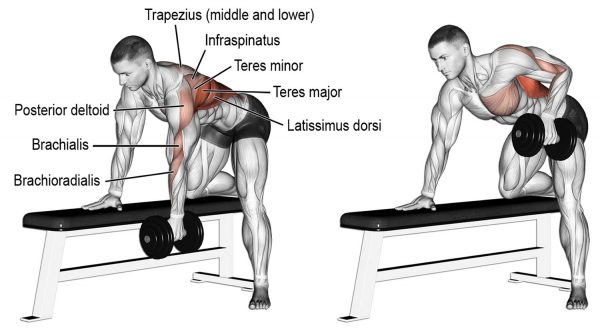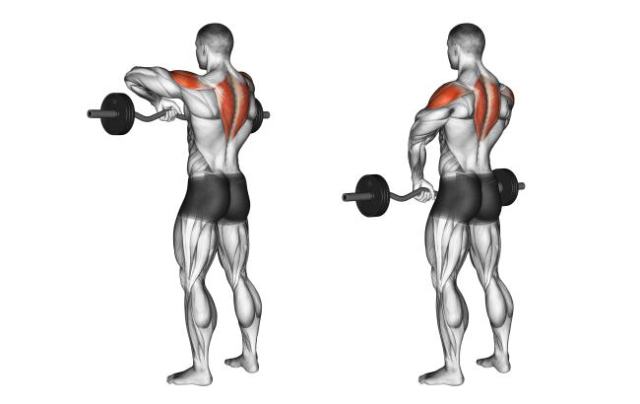7 Must-Do Moves for Getting V-Taper Shape
You can’t have a truly impressive physique without developing an impressive back. And the most prominent characteristic of a greatly developed back is the manly V-taper shape.
If there’s anything you should focus on to make your physique stand out, it’s building a thick, wide, 3D back that demands respect and makes heads turn as you walk by.
#1. Straight-Arm Pulldown
The lats are best trained with shoulder extension movements that don’t allow the biceps to get involved and steal the spotlight, and movements that enable a constant tension throughout the range of motion. And the move which meets both of these criteria is the straight-arm pull-down. This greatly under-appreciated exercise is terrific at isolating the upper lats and the teres major, which is crucial for achieving maximum back width, so it really needs to be the go-to move for anyone looking to enhance his V-taper.

#2. Dumbbell Pullover
The dumbbell pull-over is considered to be an isolation chest exercise, but in reality it’s much more than that. It’s actually a very unique exercise because it effectively works two opposing muscle groups simultaneously: the chest and the back. In addition, the main advantages of the dumbbell pull-over over the straight-arm pull-down is that it offers a greater stretch at midpoint and can be used to recruit more muscle fibers.

To reap these benefits, make sure to perform it slowly and with strict form, and keep the volume high. Lock your elbows into a slight bend and don’t move them during the exercise to avoid engaging the triceps more than required.
#3. Wide-Grip Pull-Up
While any pull-up or chin-up variation trains your lats to a certain extent, going as wide as possible ensures maximum lat development, and multiple studies have confirmed this. In fact, the wide-grip pull-up makes you forcefully spread the scapulae and pull out your lats nice and wide so that your body forms a Y shape like no other exercise could do.
Furthermore, this exercise will also powerfully train your core muscles. Although your midsection doesn’t move during the movement, your anterior core gets stronger by having to work overtime to maintain balance and stability.

So, the wider your hand position, the greater the emphasis on your outer lats. To ensure maximum effectiveness, aim to complete a full range of motion and focus on consciously engaging your lats as you bring your body toward the bar.
#4. Seated Cable Rows
The seated cable row exercises multiple muscle groups and major joints in the body, and what’s most important for us, it effectively works the entire back by training the erector spinae in the lower and middle back, the trapezius in the upper back, the rhomboids and latissimus dorsi in the middle and the teres major in the outer back. That’s a lot of benefits from one single move, so you better take full advantage of it.

Seated Cable Rows
Here are some form tips for getting optimal results. First, employ an underhand grip to force your elbows to stay close to the body during the contraction which delivers a direct hit to the outer back muscles. Also, focus on getting a full stretch on every rep and make sure to pull the bar into the lower stomach to maximally engage the lats. Finally, keep your torso upright with a raised chest and maintain a slight arch in the lower back all through the movement.
#5. Single-Arm Dumbbell Row
Performing single-arm dumbbell rows after the compound exercises is a smart way to achieve better isolation of the upper back. Also, rowing patterns can build serious thickness by allowing you to work one side at a time and really upgrade the firing power of muscle fibers on both sides of the body.

When done properly, dumbbell rows will help you build mass in the lower and center back, so strict form is crucial. Also, choose a relatively lighter weight than what you’re used to. You should be able to bring the weight up towards the abdomen by engaging the target muscles, not by rotating the torso or driving the hips. Avoid swinging and using momentum to help you move the weights and aim to get a full stretch at the bottom and a maximum contraction at the top at every rep.
#6. Side Lateral Raise
The side lateral raise is one of the best builders of the medial deltoid head, which is responsible for boosting the width of the side of the shoulders, so you really shouldn’t be missing out on this move.

On a side note, most of the guys who find this exercise to be useless are guilty of lifting via momentum and using too much weight. In that context, any exercise is useless if you don’t lift the weight via muscular action. To target your muscles with side lateral raises the way the exercise is designed to do, don’t allow any swinging of the torso and maintain a strict form at all times.
#7. Barbell Upright Row
Lastly, don’t forget about the upright row, which in our opinion is the second best exercise for polishing up your V-taper after the side laterals. Upright rows primarily target the upper traps, all three deltoid heads and biceps.

Barbell Upright Row
To get best results, make sure your grip is at least shoulder width or even a couple of inches wider. A wider grip will automatically recruit all three delt heads more intensely. At peak contraction, the bar should only reach nipple level and your elbows should be higher than your hands. Do not use your knees, hips or back to jerk the weight up – that will only minimize the effectiveness of the exercise.
Building an impressive V-taper isn’t really rocket science, and anyone can develop a much better-looking, wider back. All you have to do is to train the right muscles with the right intensity. Start with these 7 moves and bring your physique to a new level of manliness!

